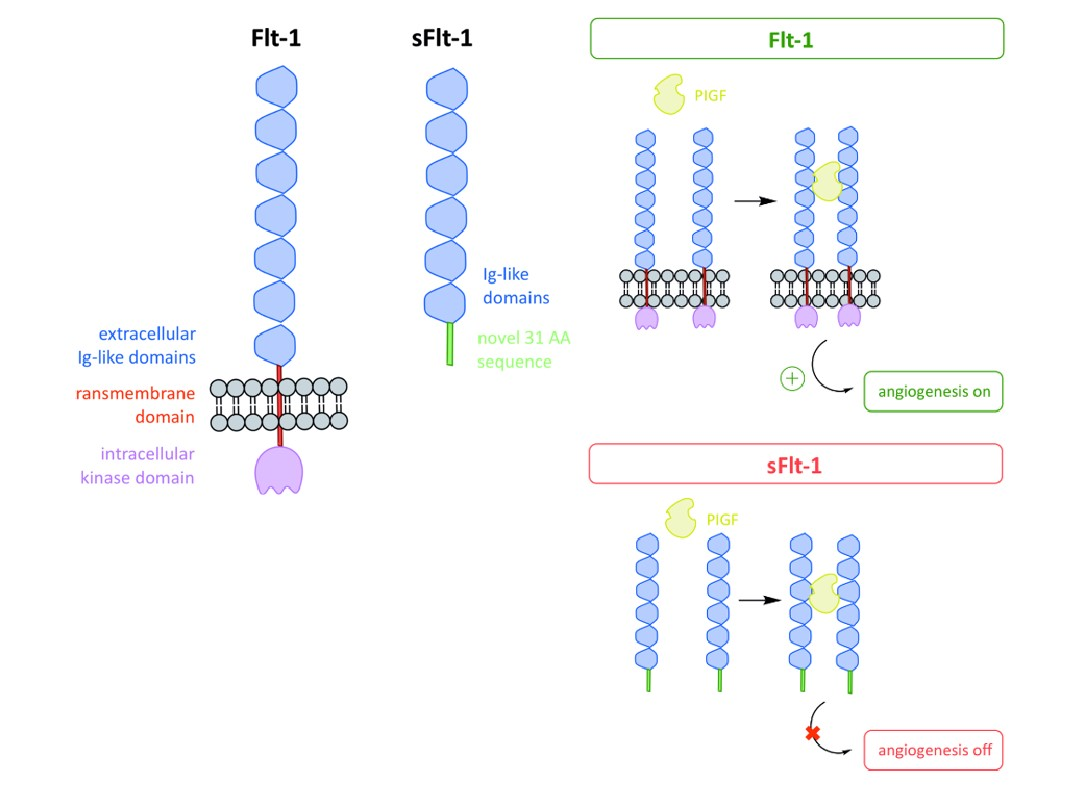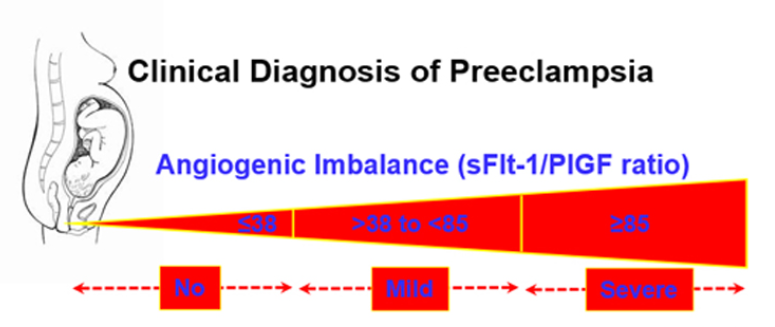Soluble Fms-like Tyrosine Kinase 1 (sFlt-1): A Precise Predictor of Pregnancy-Related Risks


Figure 1: Structural and Functional Differences Between Flt-1 and sFlt-1

Figure 2: Impact of Preeclampsia

Figure 3: Clinical Value of the sFlt-1/PlGF Ratio in Diagnosis
-
sFlt-1/PlGF ratio ≤ 38: Negative predictive value (excluding preeclampsia within one week) is 99.3%.
-
sFlt-1/PlGF ratio > 38: Positive predictive value (predicting preeclampsia within four weeks) is 36.7%.
-
sFlt-1/PlGF ratio < 33: Excludes preeclampsia.
-
sFlt-1/PlGF ratio > 85: Early-onset (20–33+6 weeks), diagnosis of preeclampsia.
-
sFlt-1/PlGF ratio > 110: Late-onset (34 weeks to delivery), diagnosis of preeclampsia.
Starter has introduced a highly sensitive sFlt-1 mouse monoclonal antibody and now offers multiple pairs of high-specificity sFlt-1 rabbit/mouse antibodies. The sensitivity for detecting and quality controlling the target protein is less than 10 pg/ml!
We are dedicated to providing high-quality raw materials for sFlt-1 detection to our global partners and offering more accurate and reliable diagnostic services to patients worldwide. Inquiries are welcome.
Product Information
| Gatalog Num | Product Name | Product Parameters | Price |
| S0B3144 | IGFBP4 Recombinant Rabbit mAb (SDT-187-35) | Host : Rabbit | Inquiry |
| Conjugation : Unconjugated | |||
| S0B3143 | IGFBP4 Recombinant Mouse mAb (SDT-185-H182) | Host : Mouse | Inquiry |
| Conjugation : Unconjugated | |||
| S0B3142 | sFlt-1 Recombinant Rabbit mAb (SDT-233-2) | Host : Rabbit | $645 |
| Conjugation : Unconjugated | |||
| S0B3141 | sFlt-1 Recombinant Rabbit mAb (SDT-233-26-2) | Host : Rabbit | $645 |
| Conjugation : Unconjugated | |||
| S0B3140 | sFlt-1 Recombinant Rabbit mAb (SDT-233-26) | Host : Rabbit | $645 |
| Conjugation : Unconjugated |
Reference
[1] Palmer K R , Tong S , Kaitu'U-Lino T J .Placental-specific sFLT-1: role in pre-eclamptic pathophysiology and its translational possibilities for clinical prediction and diagnosis[J].Molecular Human Reproduction, 2016.
[2] Fan X, Rai A, Kambham N, Sung JF, Singh N, Petitt M, Dhal S, Agrawal R, Sutton RE, Druzin ML, Gambhir SS, Ambati BK, Cross JC, Nayak NR. Endometrial VEGF induces placental sFLT1 and leads to pregnancy complications. J Clin Invest. 2014 Nov;124(11):4941-52.
[3]Maynard S E , Venkatesha S , Thadhani R ,et al.Soluble Fms-like Tyrosine Kinase 1 and Endothelial Dysfunction in the Pathogenesis of Preeclampsia[J].Pediatric Research, 2005, 57(5 Part 2):1R.
[4]Tianhua Hg, Shamim R, et al.Prenatal screening for preeclampsia: the roles of placental growth factor and pregnancy–associated plasma protein A in the first trimester and placental growth factor and soluble fms-like tyrosine kinase 1–placental growth factor ratio in the early second trimester[J].AJOG Global Reports,2023,3(2)
[5]The Chinese Society of Obstetrics and Gynecology, Pregnancy Hypertension Disease Group. Guidelines for Diagnosis and Treatment of Pregnancy Hypertension Diseases.(2020)[J].[2024-03-31].
[6]Leanos-Miranda, AlfredoGraciela Nolasco-Leanos, AnaIsmael Carrillo-Juarez, ReyesJose Molina-Perez, CarlosJanet Sillas-Pardo, LilianaManuel Jimenez-Trejo, LuisIsordia-Salas, IrmaLeticia Ramirez-Valenzuela, Karla.Usefulness of the sFlt-1/PlGF (Soluble fms-Like Tyrosine Kinase-1/Placental Growth Factor) Ratio in Diagnosis or Misdiagnosis in Women With Clinical Diagnosis of Preeclampsia[J].Hypertension: An Official Journal of the American Heart Association, 2020, 76(3).
[7]Verlohren S , Herraiz I , Lapaire O ,et al.New gestational phase-specific cutoff values for the use of the soluble fms-like tyrosine kinase-1/placental growth factor ratio as a diagnostic test for preeclampsia.[J].Hypertension, 2014, 63(2):346-352.




